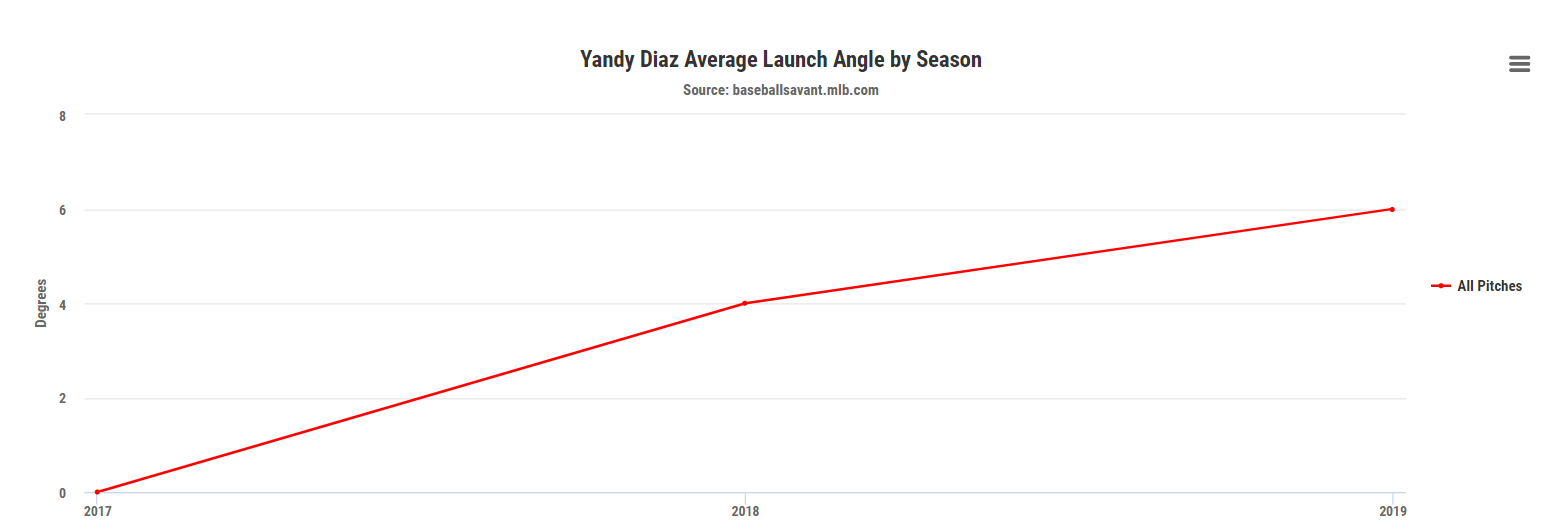Sam Chinitz analyzes batters who could become power risers in 2020 with an adjustment to their launch angle based on last year's Statcast numbers. These players could be undervalued draft targets for home runs.
Hitting the ball in the air more frequently doesn’t always mean more home runs, but an increased launch angle certainly doesn’t hurt. Of the top-20 qualified batters by launch angle last season, only two failed to hit at least 20 home runs, and the group averaged more than 30 homers.
Granted, many of those batters pair their fly-ball heavy batted ball profiles with impressive power, but the list includes below-average power hitters as well. Omar Narvaez and Paul DeJong both posted below-average hard-hit rates and average exit velocities but managed to combine for 52 home runs last season thanks in part to their near-20-degree average launch angles.
None of the four players below are likely to post average launch angles that approach 20-degrees, but each of them is an increased launch angle away from a potentially significant increase in home runs.
Be sure to check all of our fantasy baseball lineup tools and resources:- Fantasy baseball trade analyzer
- BvP matchups data (Batter vs. Pitcher)
- PvB matchups data (Pitcher vs. Batter)
- Who should I start? Fantasy baseball comparisons
- Daily MLB starting lineups
- Fantasy baseball closer depth charts
- Fantasy Baseball live scoreboard
- Fantasy baseball injury reports
Yandy Diaz (3B, TB)
Diaz posted an impressive 4.1% home run rate last season, but that number could be substantially higher with a heightened average launch angle. Last season, Diaz’s 97 mph average exit velocity on fly-balls and line drives ranked 11th in the league, ahead of hitters including Bryce Harper, Christian Yelich, and Peter Alonso.
Daiz paired his elite power with an unremarkable 5.7-degree average launch angle though, depriving him of a number of potential home runs. The good news is that Daiz has been improving his launch angle over the past few years, as the graph below demonstrates.

It’s not a huge sample of games, but Diaz has seen his fly-ball rate rise in each of the past two years (51.2% last year), and his average launch angle rose in nearly every month last season. Combined with more regular playing time, an increase in Diaz’s average launch angle in 2020 should be a recipe for significant added home runs.
Wilson Ramos (C, NYM)
Thanks to his solid 93.7 mph average exit velocity on fly-balls and line drives, Ramos posted an above-average 10.2% HR/FB ratio last season. Even so, Ramos’ 2.7% home run rate sat well below the 3.6% league average due to the catcher’s zero degree average launch angle and 63.4% ground-ball rate. Ramos’ lack of fly-balls made him the only qualified batter with a HR/FB ratio above 10% and a home run rate below 3%. Of the 11 players with a HR/FB ratio between 10% and 11%, Ramos owned the worst home run rate by far, with the group averaging a home run rate of 3.94%.
Last season was Ramos’ first time posting an average launch angle below four degrees (at least since Statcast began tracking the stat in 2015). If Ramos had kept his ground-ball rate where it sat in 2018 (55%) while maintaining the rest of his 2019 numbers, then he would’ve hit an additional five home runs last year. Expect a home run bump from Ramos this season if he can get his average launch angle back towards his career average.
Jorge Alfaro (C, MIA)
Alfaro’s 3.9% home run rate last year was respectable but lower than it could be due to his 4.7-degree average launch angle. With a 96.4 mph average exit velocity on fly-balls and line drives that ranked 21st in the league last year, Alfaro boasts impressive power that makes a higher home run rate within reach. Indeed, the two hitters surrounding Alfaro on the leaderboard of exit velocity on fly-balls and line drives in 2019 are Peter Alonso and Rafael Devers, both of whom hit more than 30 home runs last season.
Of course, Alonso and Devers hit the ball in the air far more often than Alfaro as both hitters posted average launch angles above 10 degrees. Alfaro shouldn’t be expected to raise his average launch angle up over 10 degrees, but the catcher posted a launch angle north of 8 degrees in both 2017 and 2018, so a launch angle bounceback isn’t out of the question.
Vladimir Guerrero Jr. (3B, TOR)
Guerrero’s rookie year was solid but somewhat underwhelming, and his 2.9% home run rate was less than impressive. One of Guerrero’s issues in 2019 was his launch angle. At 6.7 degrees, Guerrero’s average launch angle was the lowest among qualified batters on the Blue Jays by seven degrees, and the third baseman struggled to hit the ball in the air consistently. Consider the following visual of Guerrero's batted balls last season:

Guerrero's inconsistent launch angle and tendency to get on top of the ball suffocated his home run rate despite his above-average power and home run friendly home ballpark. Guerrero posted a strong 89.4 mph average exit velocity and a 38.4% hard-hit rate last season, suggesting that an above-average home run rate is achievable. Additionally, the Rogers Center was one of the most hitter-friendly ballparks for home runs last season, further boosting Guerrero’s home run potential. As a result of Guerrero’s power and home park, an increase in his average launch angle should significantly increase his home run total in 2020.
More Sabermetrics & Statcast for Fantasy Baseball
 RADIO
RADIO
























